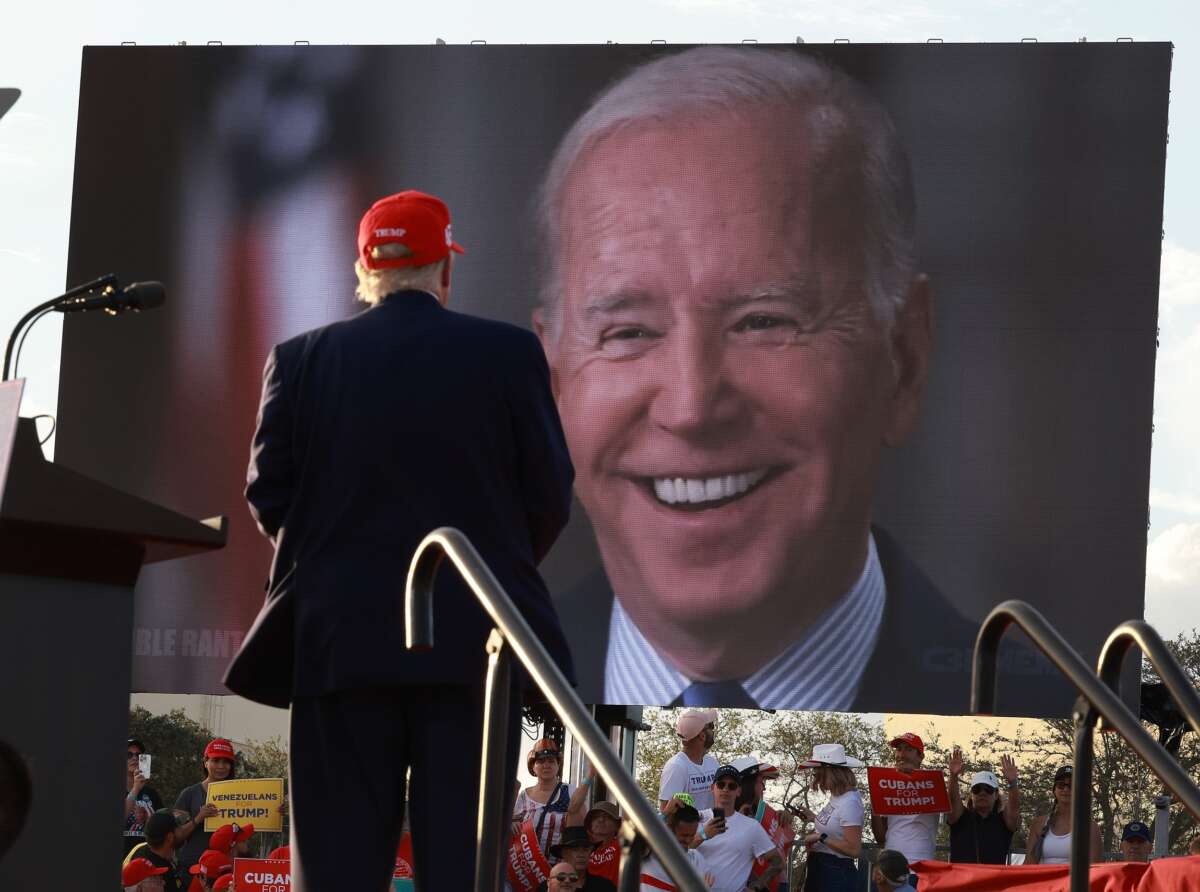A bevy of recent polling data suggests that voters are split on which candidate they would prefer in the 2024 presidential election when faced with a potential race between Democratic incumbent President Joe Biden and former president and likely Republican nominee Donald Trump.
As of Monday morning, an aggregate of polling data from RealClearPolitics shows that Biden is leading Trump by just 0.4 percent. That’s well within the margin of error — indeed, in nine of the last 10 polls shared to the site, the two are statistically tied.
Although the election is still more than a year away, the data is worrying some Democrats, who fear that a close race will benefit Trump when it comes to the Electoral College.
Conventional wisdom suggests that Republicans generally outperform Democrats in the Electoral College, even when the electorate is nearly evenly split — in 2016, for example, Trump won the presidency in spite of losing the popular vote by around two million votes to Democratic candidate Hillary Clinton. In 2020, though Trump lost to Biden by around seven million votes overall, he was within 45,000 votes in three different swing states of being re-elected through the Electoral College.
But experts have been challenging the prevailing wisdom that Trump will perform better in the Electoral College than Biden, even if the final vote count is split.
According to an analysis from The New York Times’s chief political analyst Nate Cohn, Trump’s advantage in a “close race” Electoral College scenario is dwindling. Cohn cites the fact that Biden is faring “as well or better” than Trump in nationwide polling of battleground states.
“At this point, another large Trump Electoral College advantage cannot be assumed,” Cohn wrote in a column published on Monday. “At the very least, tied national polls today don’t mean Mr. Trump leads in the states likeliest to decide the presidency.”
There are numerous indications that Trump’s advantage in this respect is fading, Cohn said. In the 2022 midterms, which Republicans won only by a narrow margin (despite widespread predictions of a substantial “red wave”), most Republican gains came from states that didn’t see much competition, whereas the expected 2024 battleground states saw closer results.
“Republicans showed their greatest strengths in noncompetitive states like California and New York as well as across much of the South, including newly noncompetitive Florida,” Cohn said. But in places like Wisconsin or Pennsylvania, the results differ vastly from those in 2020.
Cohn also pointed out that polling in these and other battleground states tends to show Biden faring better than Trump. In a New York Times/Siena poll published last month, for instance, Biden led Trump by just two points. In the battlegrounds, meanwhile, the incumbent president led the GOP candidate by double that amount.
There are other indicators that suggest the election will be close, but more difficult for Trump to win than Biden. The mere fact that Biden is the incumbent president gives him an automatic advantage — only two incumbents in the past 30 years (Trump being one of them) have failed to be re-elected. Only 10 incumbent presidents in U.S. history have failed to win the presidency for a second term.
Notably, favorability ratings don’t have to be perfect for a president to be re-elected — months before their respective re-election campaigns, both former Presidents George W. Bush and Barack Obama, who went on to win their contests, were in the low-40s range — and Biden’s current numbers (41 percent favorable, 55 percent unfavorable in one recent poll) appear to be just slightly better than Trump’s (40 percent favorable, 58 percent unfavorable).
The issues that the 2024 general election will center on will also likely benefit Biden. On abortion, Social Security and Medicare, LGBTQ rights, and other issues, Biden’s views are more closely aligned with the American public than Trump’s are.
The 2024 election campaign is still several months from taking off, and numerous factors could alter the paths of the two leading candidates within the next year. But conventional wisdom from past elections — that a close race will boost Trump’s chances in the Electoral College — no longer seems relevant.
Angry, shocked, overwhelmed? Take action: Support independent media.
We’ve borne witness to a chaotic first few months in Trump’s presidency.
Over the last months, each executive order has delivered shock and bewilderment — a core part of a strategy to make the right-wing turn feel inevitable and overwhelming. But, as organizer Sandra Avalos implored us to remember in Truthout last November, “Together, we are more powerful than Trump.”
Indeed, the Trump administration is pushing through executive orders, but — as we’ve reported at Truthout — many are in legal limbo and face court challenges from unions and civil rights groups. Efforts to quash anti-racist teaching and DEI programs are stalled by education faculty, staff, and students refusing to comply. And communities across the country are coming together to raise the alarm on ICE raids, inform neighbors of their civil rights, and protect each other in moving shows of solidarity.
It will be a long fight ahead. And as nonprofit movement media, Truthout plans to be there documenting and uplifting resistance.
As we undertake this life-sustaining work, we appeal for your support. Please, if you find value in what we do, join our community of sustainers by making a monthly or one-time gift.
